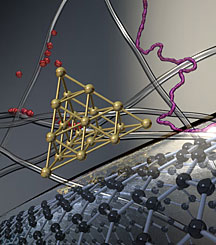- Number 362 |
- May 7, 2012
Novel composite materials demonstrate ultra-sensitivity

An artistic representation of the
synthesis process of gold
nanowires
on functionalized
single-walled carbon
nanotubes.
The growth mechanism of
gold
nanowires identified contains an
ensemble of adsorption/desorption,
shuttling and nanowelding elementary
steps.
Nanoscale building blocks allow scientists to create new complex architectures. The resulting novel materials have unique structures and functions that can achieve amazing laboratory results.
Scientists at the University of Pittsburgh and DOE's National Energy Technology Laboratory (NETL) have successfully developed a method to self-assemble gold into nanowires for gas sensing applications. Their strategy is a bottom-up approach in which gold nanowires are built from gold nanoparticles in aqueous suspensions of single-walled carbon nanotubes treated with various coatings. In a complementary effort, the mechanisms that describe the observed growth of the gold nanowires, (composed of an ensemble of adsorption/desorption, shuttling and nanowelding) have also been deduced. The elementary steps of this mechanism were demonstrated through first principles density functional theory calculations and validated with X-ray diffraction and transmission electron microscopy measurements.
In tests to determine the composite materials’ effectiveness in sensing applications, an ultra-sensitivity to hydrogen sulfide in both the parts per billion (ppb) and parts per million (ppm) concentrations was demonstrated with a detection limit as low as 5 ppb at room temperature. A hybrid gold nanowire-carbon nanotube material, and the associated device, has potential application as a portable detection sensor in very diverse areas ranging from the natural gas industry to personal safety and personal healthcare.
The results of this combined experimental and theoretical study were recently published in the premier Journal of the American Chemical Society: “Welding of Gold Nanoparticles on Graphitic Templates for Chemical Sensing” by Mengning Ding, Dan C. Sorescu, Gregg P. Kotchey, and Alexander Star.
The importance of the results obtained resides not only in development of a synthesis method to grow gold-nanowires on carbon nanotubes templates, but in a development, based on both experimental and first principles computational results, of a nanowelding model that explains the overall growth mechanism. Additionally, the composite materials obtained were tested for gas sensing applications, and an ultra-sensitivity to hydrogen sulfide to levels as low as 5 parts per billion was demonstrated.
Development of chip-based sensors that rely on nanomaterials to detect hydrogen sulfide in complex mixtures of gases also opens practical ways to create portable and less expensive devices with direct applications in natural gas and gas well industries, personal safety, and healthcare. Carbon nanotubes are one of the most promising inorganic templates for this strategy because of their unique physical, chemical, and mechanical properties, which translate into numerous potential applications.
A Chemical & Engineering News story written by Katherine Bourzac about this technology, “Gold Nanowires Sense Gas,” can be found here.
[Linda Morton, 304.285.4543,
Linda.morton@netl.doe.gov]
